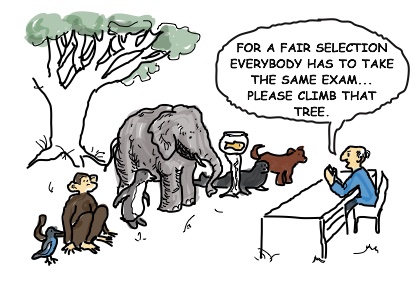The teacher begins by explaining that the class is going to be celebrating a birthday and that the earth has traveled around the sun four times since the birthday girl was born.
A “sun” is created in the center of the group (in this case, the “sun” is made out of small chocolate treats). The teacher reminds the children that the sun is at the center of our solar system, and that the earth travels around it just one time each year. The birthday girl holds a globe (which represents the earth) and she begins her journey around the “sun” – one time for each year of her life.
Once the child finishes her symbolic journey, her classmates sing “Happy Birthday” and the students share in a special birthday treat – a piece of our chocolate sun!
]]>Although some of the tools and methods may have evolved, the fundamental tenets of the Montessori philosophy continues to hold true today. And we know that how? Because 110 years of proven success tells us so.
]]>Watch how 3 year-old Jackson and 3 year-old Aya are learning how to not only recognize numbers, but truly comprehend what the values of those numbers represent. (Oh, and by the way, the activity they are doing is actually laying the foundation for learning about the decimal system!)
]]>
“Everybody is a genius. But if you judge a fish by its ability to climb a tree, it will live its whole life believing that it is stupid.” – Albert Einstein
Whether or not Einstein truly spoke these words, the idea that different people learn in different ways is by no means a new idea.
Dr. Howard Gardner, a Professor of Education at Harvard University, presented his Theory of Multiple Intelligences over 30 years ago. In a nutshell, Gardner challenges the standard view of intellect: That a person either is, or is not intelligent, and that intelligence can be adequately measured by IQ tests (something Mr. Einstein would surely disagree with!) Gardner argues that IQ tests typically assess linguistic and logical-mathematical intelligence; and that they “were a reasonably good predictor of who would do well in a 20th (note: Not necessarily a 21st) century secular school.” On the other hand, Gardner’s theory proposes that there are at least nine types of intelligences and that each individual has their own unique configuration of intelligences (i.e. capabilities and skills).
In terms of implications for education, Gardner believes that we should teach/mentor/nurture individuals in ways that they can learn (i.e. personalize).
Individualizing education may sound great in theory, but is it realistic?
We happen to think so. In fact, it’s called the Montessori Method… and it’s been in practice for more than a century.
As Montessori celebrates it’s 110th anniversary, it’s interesting to note that Dr. Montessori’s philosophy on learning is just as powerful and true today, as it was in the early 20th century. Yes. Times have changed. The demands of the 21st century are different, and so parents (and educators) need to ask themselves: Will the conventional approach to education truly unleash our children’s potential for maximum success in today’s world?
For those of us who tend to be ‘visually inclined’, here’s a link to a video that does a nice job of summarizing the difference between a Montessori and Conventional education.
]]>“The guide or teacher must be sure to provide the child with the right tools at the right time in the child’s development to interest the child in mathematics. If interested, the child can discover relationships for him/herself where it is understood that abstraction is an individual process that cannot be forced”. – Dr. Maria Montessori

Lower Elementary students learning how to measure the size of a room using a non-standard unit of measurement (Hint: If you know the length of a floor tile…)
At EMS, we don’t just teach children how to add and subtract, we teach them how to act and react.
In Montessori the abstract process of math is the final step of a long series of exercises. For most students who have studied within a traditional system, numbers on the page are just that – symbols they are taught how to manipulate. To Montessori students, those symbols represent very concrete ideas that they have physically manipulated; they fully understand what they mean, how they work, and how to apply.
]]>